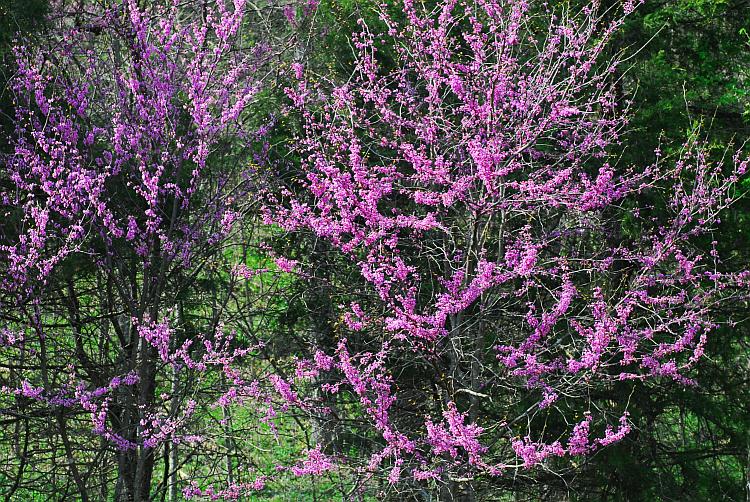Cercis canadensis L.
Eastern Redbud

Native
CC = 3
CW = 3
MOC = 78
© SRTurner
Cercis canadensis L.Eastern Redbud | |
 |
Native CC = 3 CW = 3 MOC = 78 |
© SRTurner |
|
Family - Fabaceae/Caesalpinioideae Habit - Trees 3-12 m tall with spreading crowns. Stems - Trunks single or multiple, often leaning with age, the bark smooth, dark reddish brown, becoming scaly and peeling with age, the twigs slender, zigzag, the winter buds small, rounded, with several scales. Root nodules absent. Leaves - Appearing after the flowers, simple, entire, petiolate. Petioles 3-6 cm long, swollen at both ends. Stipules minute, scalelike, shed early. Leaf blades 3-15 cm long, 3-15 cm wide, usually heart-shaped, the base cordate, angled or short-tapered to a bluntly to sharply pointed tip, the upper surface glabrous and often glossy, the undersurface glabrous to moderately but inconspicuously hairy, the venation palmate.
Inflorescences - Umbellate clusters produced on short, spurlike shoots from second-year or older twigs and branches, sometimes directly from the trunk, the flower stalks 5-11 mm long.
Flowers - Perfect, perigynous, strongly zygomorphic. Hypanthium 2-3 mm long, cup-shaped, pinkish-tinged. Calyces of 5 fused sepals, 0.5-1.0 mm long, with short, triangular teeth, persistent at fruiting. Corolla of 5 free petals, these 6-9 mm long, 3-4 mm wide, obovate, tapered to a stalklike base, pinkish purple or rarely white, the banner petal internal to the lateral petals in bud. Stamens 10, all fertile, the filaments not fused, 4-6 mm long, curved, hairy at the base, the anthers about 0.3 mm long, 0.2 mm wide, attached toward the midpoint, dehiscing by lateral slits. Style curved.
Fruits - Legumes, 6-9 cm long, 1.0-1.5 cm wide, strongly flattened, short-stalked, winged along one margin, tapered at each end, papery to leathery, glaucous, few-seeded, without cross-partitions between the seeds, tardily dehiscent, persistent into the winter. Seeds 4.0-4.5 mm long, 3.0-3.2 mm wide, ovoidelliptic to almost circular, flattened, hard, the surface smooth, reddish brown, shiny
Flowering - March - May. Habitat - Open woods, thickets, glades, rocky stream banks, bluffs, also cultivated. Origin - Native to the U.S. Lookalikes - None. Other info. - This beautiful and delightful springtime sight is common throughout Missouri and most of the eastern continental U.S. When in flower it is impossible to mistake. It is most commonly found as an understory tree, often in association with flowering dogwood. In addition to its common presence in natural communities, it is often cultivated, with a moderate size and growth habit that integrates well into landscaping plans. Splitting of mature trunks and limbs can be a problem, however. Photographs taken in Kansas City, MO., 4-28-00, and in Brown Summit, NC., 4-3-03 (DETenaglia); also at Weldon Spring Conservation Area, St. Charles County, MO, 4-21-2008, near Glecoe, St. Louis County, MO, 4-17-2010, Little Lost Creek Conservation Area, Warren County, MO, 3-30-2012, and along the Katy Trail near Dutzow, Warren County, MO, 8-26-2021 (SRTurner). |